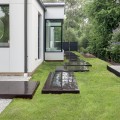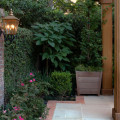Minimalist Pool
A minimalist pool follows the principles of minimalism, contemporary design, and less is more. It reduces thepool design down to its most basic elements of water and geometry. Patios are common, but not mandatory, and some pools may not even have coping around their sides.
Through size, geometry, and transitional position between the home and remainder of the landscape, the pool creates movement in both directions that draw people in the home into outdoor space, while people in the far reaches of the yard are pulled back toward the water.
Such a design creates a superb atmosphere for home entertainment, regardless of the size of the group or the time of the year.
Because of the importance of movement, most pools built with minimalism in mind are rectangular in design. Rectangles have long lateral lines that carry along with them, so they are ideal shapes for any structure that seeks to make a dynamic impact on the landscape. The rectangle is also an ideal compliment to most contemporary home architecture because the length of a home is almost always longer than its width, and the shape of the rectangle supports this design very well.
There are instances where minimalist pools are designed in a circular shape. The effectiveness of such a design depends exclusively on the layout of the surrounding terrain and the home itself. Because many contemporary homes are built with one of their walls in the form of a radius, a radial design for the pool mirrors the sweeping curvature of the wall. Patio space between the wall and the pool can also feature radial surface designs so as to create the feeling of moving through space in an infinite arc.
Regardless of its shape, it is very important that the minimalist pool feature a high level of luminance either by reflecting natural sunlight or by means of artificial pool lighting. Light is essential to contemporary design, so it is necessary to build the structure in a location free from shadows and obstructions.
A minimalist pool will have a patio that contributes to the lighting in some capacity. The surface does not have to be light in color per se, but it needs to at least reflect light well. Stone is sometimes used, provided it is polished. Individual stones must feature a simple consistent geometry as well that supports either the linear or radial movement of the water in the pool. Ostentatiousness must be avoided at all costs.
Another popular patio material is aggregate. Various crushed stones, such as limestone, create a highly reflective surface that is both light in color and very durable. Decorative concrete is another popular material, with any number of colors being finished off with a fine surface finish for reflectivity.
In almost every project, the top of the water will be a mere inches from the edge of the patio. This sheer drop off creates an absolute contrast of surface areas without overcomplicating the simplicity of minimal design. Such an effect is even more pronounced when a minimalist pool is built in a central portion of the yard in what we call the grass patio design.
In this design, there is only a narrow coping that separates the pool from the grass, with the deep blue of the water working as a counterpoint to the lawn and surrounding landscape features. This is very avant garde, but it works exceptionally well when a landscape theme is developed on a property with more grass than one typically finds in a contemporary landscape.





